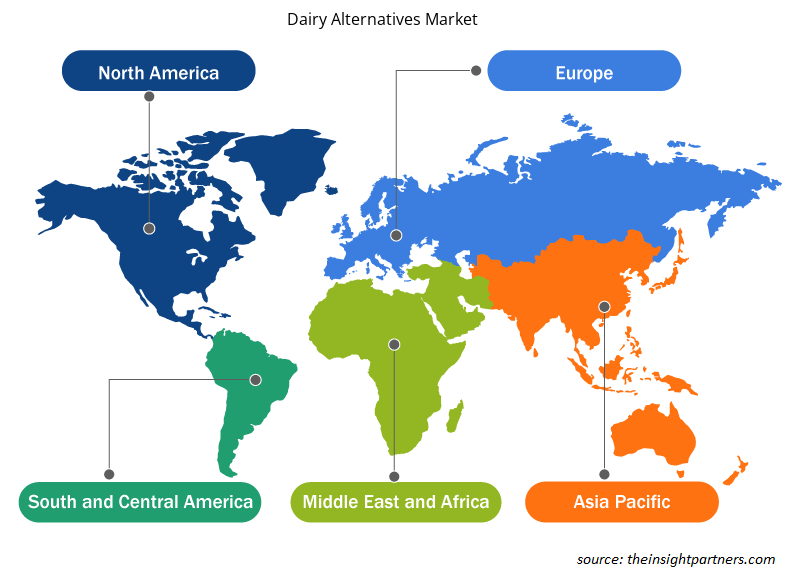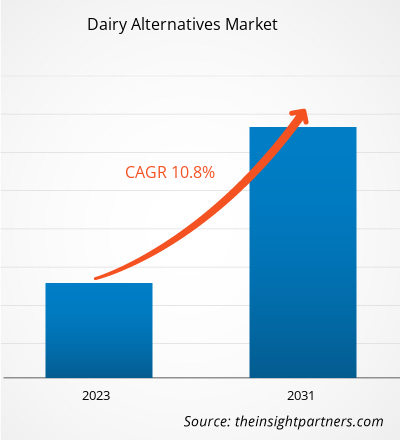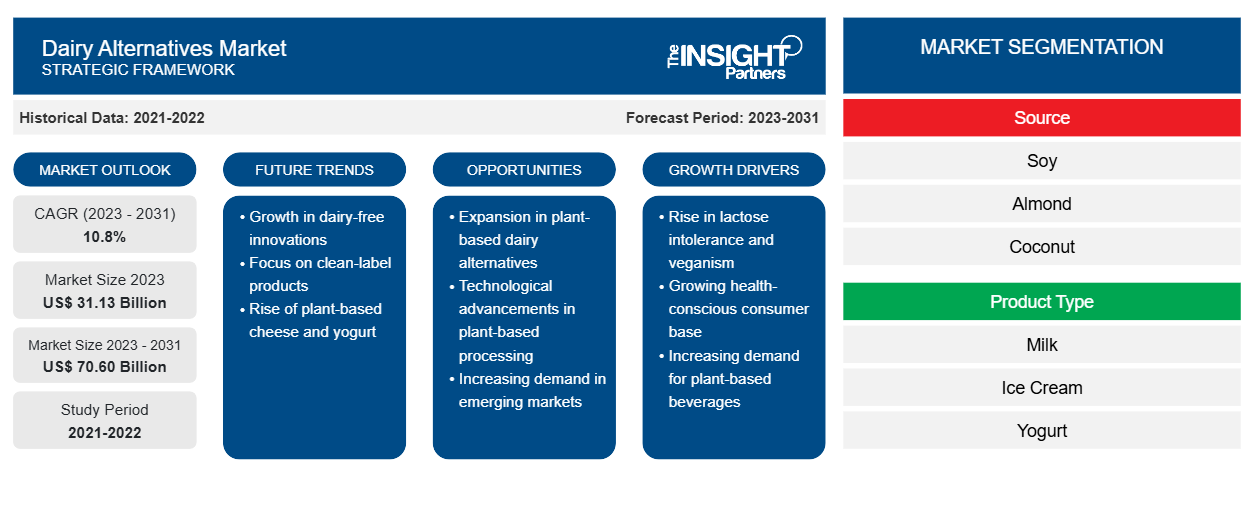乳製品代替品の市場規模は、2023年の311.3億米ドルから2031年には706億米ドルに達すると予測されています。市場は2023年から2031年の間に10.8%のCAGRを記録すると予想されています。機能性乳製品代替品の需要の急増は、引き続き市場の重要なトレンドとなると思われます。
乳製品代替品市場分析
ビーガン人口はここ数年で大幅に増加しています。Veganuary(世界中の人々に1月中ずっとビーガンになることを奨励する非営利団体)によると、2022年のVeganuaryキャンペーンには62万人以上が登録し、過去3年間で登録者数は200%増加しました。健康と持続可能性への懸念の高まりから、ビーガン食に切り替える人が増えています。畜産業は、人為的な温室効果ガスの総排出量に大きく貢献している産業の1つです。国連食糧農業機関(FAO)によると、世界中の畜産業は年間7.1ギガトンの二酸化炭素を排出しており、これは人為的な温室効果ガス総排出量の14.5%を占めています。畜産部門は畜産全体の排出量の30%を占めています。
多くの研究で、ビーガン食に切り替えると二酸化炭素排出量を大幅に削減できることが示されています。スウェーデンのチャルマース工科大学の教授であり、雑誌「気候変動」に掲載された肉と乳製品の消費に関する研究論文の共著者であるフレドリック・ヘデヌス博士によると、肉と乳製品の消費を減らすことは、農業による気候汚染を許容レベルまで下げるために非常に重要になる可能性があるとのことです。
さらに、国連、PETA、Good Food Institute などの多くの組織は、ビーガン主義が気候危機から地球を救うのに役立つと考えています。畜産業が環境に及ぼす有害な影響に関する意識は、消費者の間で高まっています。植物由来の乳製品の消費は、二酸化炭素排出量を最小限に抑え、水やその他の天然資源を節約し、全体的な環境への影響を軽減するのに役立ちます。そのため、消費者は急速に植物由来の乳製品や肉製品に切り替えています。この要因は、乳製品代替品市場を大きく推進しています。
乳製品代替品市場の概要
牛乳、ヨーグルト、アイスクリーム、チーズ、バターなどの乳製品代替品は、豆乳、エンドウ豆乳、ココナッツミルクから作られています。豆乳は他の植物性ミルクよりも手頃な価格で、全乳と同量のタンパク質を提供します。消費者は、健康への懸念の高まりと動物福祉への意識の高まりにより、植物ベースまたはビーガンフレンドリーな製品に非常に傾倒しています。植物ベースの製品は、一般的に健康的な代替品であると認識されています。さらに、酪農は環境全体に悪影響を及ぼし、気候変動につながっています。この要因も乳製品代替品市場の成長に影響を与えています。
要件に合わせてレポートをカスタマイズする
このレポートの一部、国レベルの分析、Excelデータパックなど、あらゆるレポートを無料でカスタマイズできます。また、スタートアップや大学向けのお得なオファーや割引もご利用いただけます。
- このレポートの主要な市場動向を入手してください。この無料サンプルには、市場動向から見積もりや予測に至るまでのデータ分析が含まれます。
乳製品代替品市場の推進要因と機会
乳糖不耐症の増加が市場を有利に導く
国立糖尿病・消化器・腎臓病研究所 (NIDDK) によると、世界人口の平均 68% が乳糖不耐症を患っています。国立衛生研究所 (NIH) によると、乳糖不耐症は東アジアの成人に非常に多く見られ、これらのコミュニティの人々の 75~95% が影響を受けています。さらに、先天性乳糖欠乏症はアジア太平洋地域とアフリカで広く見られます。したがって、中国、日本、韓国、台湾などの国は乳製品の代替品の潜在的な市場です。
植物由来の乳製品は、従来の乳製品と同様の食感、クリーミーさ、粘稠度を備えています。消費者の毎日の栄養要件を満たすために、タンパク質やカルシウムなどの栄養素が強化されています。そのため、消費者の間で乳糖不耐症や牛乳アレルギーがますます増加していることが、乳製品代替品市場を牽引しています。
新製品の発売数の増加により、大きな成長機会が生まれる
乳製品代替品メーカーは、幅広い消費者層にアピールするために、製品イノベーションに多額の投資を行っています。製品イノベーション戦略は、市場で活動するプレーヤーに競争上の優位性を提供し、収益性を高めます。乳製品代替品メーカーは、新たな顧客の要件に対応するために、認定オーガニック、非遺伝子組み換え、グルテンフリー、クリーンラベル、アレルゲンフリーの製品を提供しています。さらに、消費者は健康志向が高まっており、低カロリーで低脂肪の製品を好むようになっています。そのため、植物ベースの乳製品メーカーは、無糖で低糖の製品を提供しています。たとえば、2021年2月、Hasla Foodsは24オンスのファミリーサイズのゼロシュガーオーツミルクヨーグルトを発売しました。この製品は1食分あたりわずか90カロリーで、砂糖は添加されていません。2021年6月、同社は米国の160のNational Grocers by Vitamin Cottage店舗で製品を販売することで、小売店の展開を拡大しました。
さらに、メーカーは、大麦、エンドウ豆、麻、チアシード、バナナ、カシューナッツなど、さまざまな植物性ミルクの原料を試しています。たとえば、植物性ミルクの主要メーカーの 1 つである Take Two Foods は、タンパク質、繊維、カルシウム、不飽和脂肪などの栄養素の完全なポートフォリオを備えた栄養強化大麦ミルクを提供しています。このような戦略は、予測期間中に乳製品代替品市場に有利な機会をもたらすと予想されます。
乳製品代替品市場レポートのセグメンテーション分析
乳製品代替品市場分析の導出に貢献した主要なセグメントは、ソース、製品タイプ、流通チャネルです。
- 乳製品代替品市場は、ソースに基づいて、大豆、アーモンド、ココナッツ、オート麦、その他に分かれています。大豆セグメントは2023年に最大の市場シェアを占めました。大豆には、心臓病や乳がんのリスクを下げると言われているイソフラボンが含まれているため、米国の高齢者や女性消費者の間で人気が高まると予測されています。大豆には、女性のエストロゲンと同様に機能するホルモンである植物性エストロゲンも含まれています。大豆ベースの乳製品代替品の摂取は、エストロゲンレベルを上げる代替療法として女性の間で人気があります。大豆は栄養素が豊富で、他の乳製品代替品と比較してタンパク質含有量が高いため、その利点に対する大豆の人気は、予測期間中にこのセグメントの市場を牽引することにつながります。
流通チャネルの面では、市場はスーパーマーケットとハイパーマーケット、コンビニエンスストア、オンライン小売、その他に分類されています。スーパーマーケットとハイパーマーケットのセグメントは、2023年に市場を支配しました。スーパーマーケットとハイパーマーケットは、食料品、食品、飲料、その他の家庭用品を幅広く取り揃えた大規模な小売店です。これらの店舗では、さまざまなブランドの製品が手頃な価格で入手できるため、買い物客は適切な製品をすばやく見つけることができます。さらに、これらの店舗では、魅力的な割引、複数の支払いオプション、快適な顧客体験を提供しています。スーパーマーケットとハイパーマーケットは、利益率を高めるために製品の販売を最大化することに重点を置いています。植物ベースの乳製品の製造業者は通常、これらの店舗の来店客数が多いため、スーパーマーケットやハイパーマーケットを通じて製品を販売することを好みます。都市化の進展、労働者階級の人口の増加、競争力のある価格設定により、先進地域と発展途上地域でスーパーマーケットとハイパーマーケットの人気が高まっています。
地域別乳製品代替品市場シェア分析
乳製品代替品市場レポートの地理的範囲は、主に北米、アジア太平洋、ヨーロッパ、中東およびアフリカ、南米/中南米の 5 つの地域に分かれています。
アジア太平洋地域の乳製品代替品市場は、2023年に最大の市場シェアを占めました。近年、乳糖不耐症の人々の増加や、牛乳によく含まれる抗生物質や成長ホルモンに対する健康上の懸念により、ミルク代替品の消費は着実に増加しています。楽天が2021年に実施した調査によると、中国の消費者の87%が植物性ミルクを試したことがあり、50%が他の乳製品代替品を試したことがあり、42%が植物性肉を試したことがあり、32%がビーガン卵代替品を試したことがありました。さらに、同じ調査で、回答者の3%が植物性食品のみを消費していることがわかりました。このように、アジア太平洋地域での乳糖不耐症の蔓延により植物性乳製品の需要が高まっているため、ミルク代替品市場は成長しています。
乳製品代替品市場の地域別分析
予測期間を通じて乳製品代替品市場に影響を与える地域的な傾向と要因は、Insight Partners のアナリストによって徹底的に説明されています。このセクションでは、北米、ヨーロッパ、アジア太平洋、中東、アフリカ、南米、中米にわたる乳製品代替品市場のセグメントと地理についても説明します。

- 乳製品代替品市場の地域別データを入手
乳製品代替品市場レポートの範囲
| レポート属性 | 詳細 |
|---|---|
| 2023年の市場規模 | 311.3億米ドル |
| 2031年までの市場規模 | 706億米ドル |
| 世界のCAGR(2023年~2031年) | 10.8% |
| 履歴データ | 2021-2022 |
| 予測期間 | 2023-2031 |
| 対象セグメント | 出典別
|
| 対象地域と国 | 北米
|
| 市場リーダーと主要企業プロフィール |
|
乳製品代替品市場のプレーヤー密度:ビジネスダイナミクスへの影響を理解する
乳製品代替品市場は、消費者の嗜好の変化、技術の進歩、製品の利点に対する認識の高まりなどの要因により、エンドユーザーの需要が高まり、急速に成長しています。需要が高まるにつれて、企業は提供品を拡大し、消費者のニーズを満たすために革新し、新たなトレンドを活用し、市場の成長をさらに促進しています。
市場プレーヤー密度とは、特定の市場または業界内で活動している企業または会社の分布を指します。これは、特定の市場スペースに、その市場規模または総市場価値に対してどれだけの競合相手 (市場プレーヤー) が存在するかを示します。
乳製品代替品市場で事業を展開している主要企業は次のとおりです。
- サンオプタ
- ブルーダイヤモンド栽培者
- ネスレSA
- ダノンSA
- オートリー株式会社
- カリフィアファームズ LLC
免責事項:上記の企業は、特定の順序でランク付けされていません。

- 乳製品代替品市場のトップキープレーヤーの概要を入手
乳製品代替品市場のニュースと最近の動向
乳製品代替品市場は、主要な企業出版物、協会データ、データベースを含む一次調査および二次調査後の定性的および定量的データを収集することによって評価されます。以下は、発話および言語障害の市場における動向の一覧です。
- 植物由来ミルクブランドのミルカダミアは冷蔵市場に参入し、オーガニックのアルチザンマカダミアミルクとブレンドラインのデビューで「少ないほど豊か」を証明しました。このラインは、多くの非乳製品飲料によくある増量剤やガムを使わず、より自家製に近い選択肢を求める需要の高まりに応えています。(出典:乳製品代替品 - ミルカダミア、プレスリリース/企業ウェブサイト/ニュースレター、2024年)
- カリフィアファームズは、9種類の必須栄養素、8グラムのタンパク質、9種類の必須アミノ酸すべて、そして乳製品の半分の糖分を含むクリーミーな植物性ミルク、カリフィアファームズコンプリートを発売したと同社は発表した。(出典:デイリーオルタナティブズカリフィアファームズLLC、プレスリリース/企業ウェブサイト/ニュースレター、2024年)
乳製品代替品市場レポートの対象範囲と成果物
「乳製品代替品市場の規模と予測(2023〜2031年)」レポートでは、以下の分野をカバーする市場の詳細な分析を提供しています。
- 対象範囲に含まれるすべての主要市場セグメントの世界、地域、国レベルでの市場規模と予測
- 市場の動向(推進要因、制約、主要な機会など)
- 今後の主な動向
- 詳細なPEST/ポーターの5つの力とSWOT分析
- 主要な市場動向、主要プレーヤー、規制、最近の市場動向を網羅した世界および地域の市場分析
- 市場集中、ヒートマップ分析、主要プレーヤー、最近の動向を網羅した業界の状況と競争分析
- 詳細な企業プロフィール
- 過去2年間の分析、基準年、CAGRによる予測(7年間)
- PEST分析とSWOT分析
- 市場規模価値/数量 - 世界、地域、国
- 業界と競争環境
- Excel データセット
最新レポート
お客様の声
購入理由
- 情報に基づいた意思決定
- 市場動向の理解
- 競合分析
- 顧客インサイト
- 市場予測
- リスク軽減
- 戦略計画
- 投資の正当性
- 新興市場の特定
- マーケティング戦略の強化
- 業務効率の向上
- 規制動向への対応























 無料サンプルを入手 - 乳製品代替品市場
無料サンプルを入手 - 乳製品代替品市場